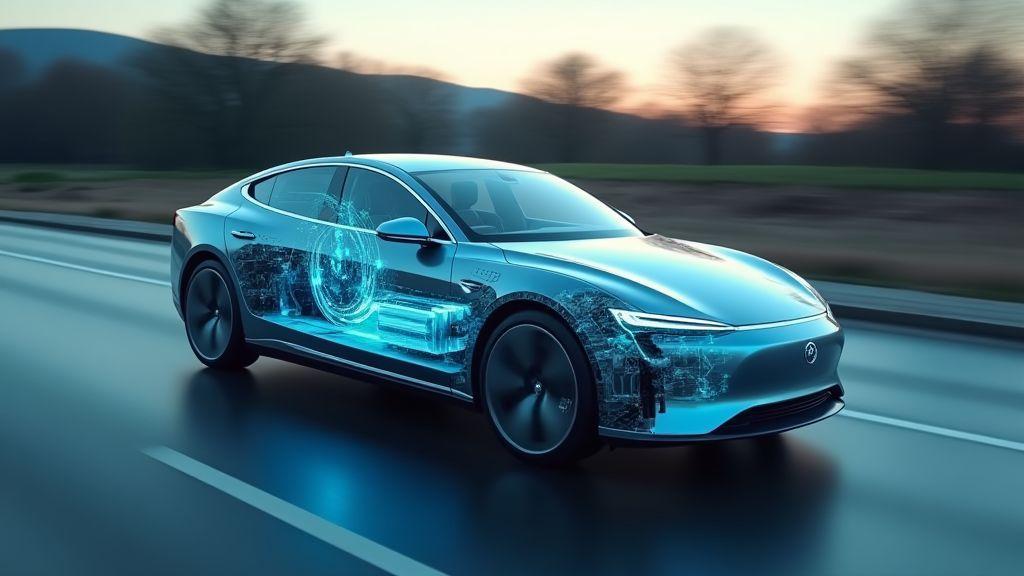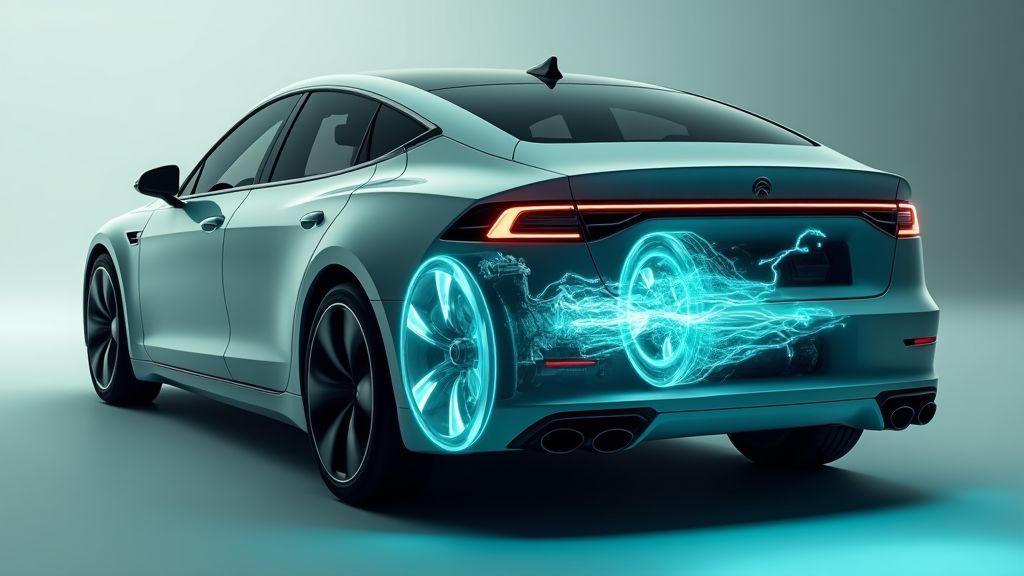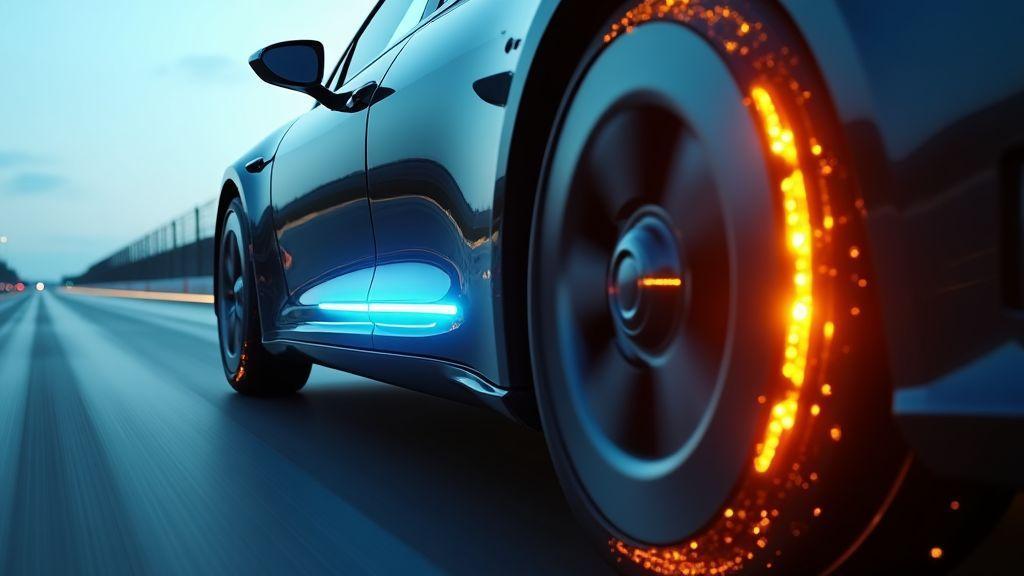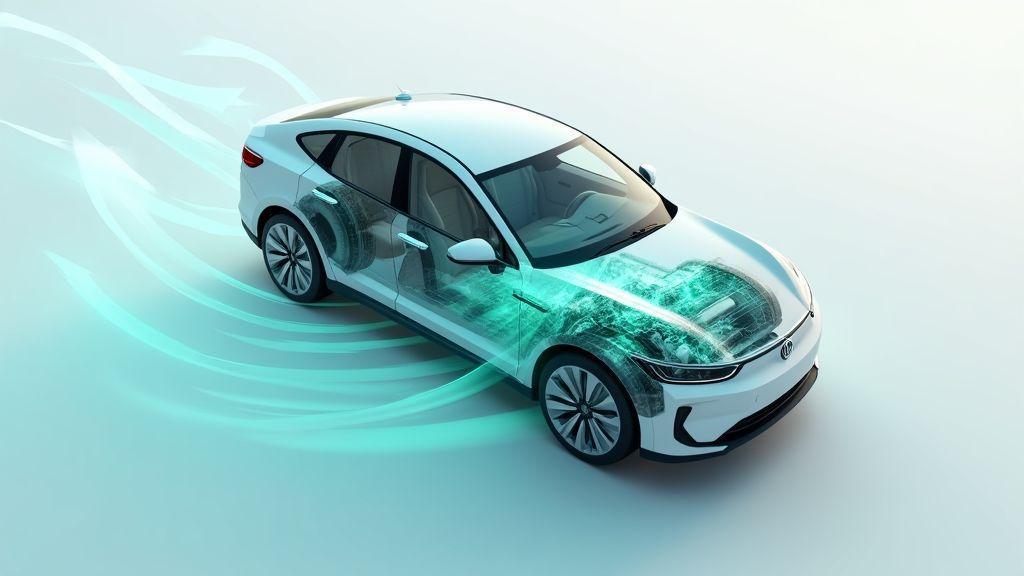How Regenerative Braking Works in Hybrid Vehicles
How Regenerative Braking Works in Hybrid Vehicles shows you how your car captures motion energy and turns it into usable battery charge. You will see how the electric motor becomes a generator, how the inverter and battery store that energy, and how sensors and brake blending keep stopping safe. It covers limits like battery charge and wasted energy, real-world factors that change efficiency, and simple driving tips to get more energy recovery while reducing wear on your brakes.
Key Takeaway
- You use the motor as a generator to capture braking energy.
- Captured energy charges the battery for later use.
- Regeneration reduces wear on your brake pads.
- The system blends electric and friction braking for safety.
- You improve fuel efficiency and cut emissions.

Basic physics of kinetic energy recovery and how regenerative braking works in hybrid vehicles
Regenerative braking is about catching the energy you would normally lose as heat when you slow down. When your car is moving, it has kinetic energy proportional to mass and speed. Hybrid systems take some of that motion energy and turn it into electricity instead of wasting it in brake pads and discs. For a concise technical reference, see the Overview of regenerative braking physical principles.
The core trick is swapping roles. The electric motor that normally pulls the car forward can switch to act like a generator. When it does, the motor resists wheel rotation and converts that spinning motion into electrical current. That current flows back into the hybrid battery, so the energy gets reused later to help accelerate or run accessories.
There are losses along the way — friction, heat in electronics, and limits in battery charging cut the recovered amount — but in stop-and-go traffic you can reclaim a good chunk of energy. Think of it like catching rainwater from a leak instead of letting it puddle on the floor: not perfect, but far better than nothing.
How the electric motor acts as a generator
An electric motor becomes a generator when the shaft is turned while the motor’s coils are connected to a load. In a hybrid, when you lift off the accelerator or press the brake, the car’s controls tell the motor to resist rotation. That resistance creates a voltage across the motor’s windings and current flows back through the power electronics.
The vehicle’s inverter and control unit shape and route that electricity so it can charge the battery. The inverter changes the motor’s AC output to DC and controls voltage and current. So when you slow down, the motor is doing double duty: helping to stop the car and sending energy back to your battery. You feel a slowing force and the battery gets a top-up.
Kinetic energy recovery in hybrids and the push to capture motion energy
You care about efficiency because saved energy means fewer trips to the pump and lower emissions. Hybrids aim to capture motion energy especially in city driving where braking is frequent. Each time you stop at a light, some kinetic energy is available to reclaim. Over many stops, the savings add up.
There are trade-offs. Batteries can only accept so much power at once. If the battery is full or you need very strong braking, the system falls back to the mechanical brakes. Still, capturing even a portion of braking energy reduces wear on pads and cuts fuel use — that makes hybrids practical and green for everyday driving.
The simple energy path from wheel to electrical charge
At a basic level:
- Wheels spin the motor.
- The motor, in generator mode, converts mechanical motion into electrical current.
- Power electronics condition that current and send it into the battery where it is stored for later use.
| Stage | What happens |
|---|---|
| Wheel rotation | Kinetic energy from motion turns the motor shaft |
| Motor as generator | Mechanical energy becomes electrical current in the windings |
| Power electronics (inverter/rectifier) | Current is converted and regulated to safe voltage and form |
| Battery | Electrical energy is stored for future use by the motor or vehicle systems |
Key parts of a hybrid vehicle regenerative braking system
Regenerative braking captures the car’s kinetic energy and turns it into electricity instead of wasting it as heat. The main parts are the electric motor (which doubles as a generator), the inverter that converts power, the high-voltage battery that stores energy, and the control systems that coordinate everything. Mechanical brakes and sensors are part of the system too because safety and consistent braking feel are non-negotiable.
Each component has a clear job during a stop or slow-down. The motor switches roles and generates electricity when the wheels force it to spin. The inverter flips that generated AC into DC or back again so the battery or motor can use it. Control units decide how much braking should be handled by the motor and when to call in the friction brakes.
Electric motor, inverter, battery, and controls explained
The electric motor in a hybrid acts as both a mover and a generator. When you accelerate, it adds torque. When you lift off the throttle or press the brake, the same motor resists wheel rotation and creates electrical power. That generated power is sent to the inverter. For an authoritative overview of how those parts interact, see How regenerative braking components work together.
The inverter and battery handle power flow and storage. The inverter converts the motor’s alternating current into direct current that the battery accepts, and it switches direction when the motor needs power again. The battery stores the recovered energy and supplies power for later acceleration. Control units and a Battery Management System (BMS) monitor state of charge, temperature, and voltage to keep everything running safely.
| Component | Primary role |
|---|---|
| Electric motor (generator mode) | Converts wheel motion to electrical energy |
| Inverter | Converts AC ↔ DC and controls motor speed |
| High-voltage battery | Stores recovered energy for reuse |
| Control units / BMS | Manage power flow, safety limits, and timing |
Sensors and brake blending that protect safety and capture energy
Sensors give the system real-time data so your brakes feel right and the car stays safe. Wheel speed sensors, brake pedal position, and yaw sensors feed the control unit. If ABS or traction control kicks in, the system adjusts regenerative output so wheels don’t lock. That keeps you stable while the hybrid still tries to pull energy back into the battery.
Brake blending is the handshake between regen and friction brakes. When you press lightly, the motor handles most braking and you recover more energy. If you stomp the pedal, the controls blend in hydraulic brakes instantly for full stopping power. The system is tuned so you rarely notice the switch — it feels like one smooth stop while the hardware does the math in the background.
- Your foot presses the pedal → sensors read intent; regen applied first for gentle stops; friction brakes add force if needed.
Think of the system as an orchestra: sensors act like the conductor, telling the motor to become a generator. The inverter translates that output into the battery’s language while the battery accepts or rejects charge based on its state. If you need extra stopping force, the hydraulic brakes jump in.

How regenerative braking charges the battery and the energy recovery process
How Regenerative Braking Works in Hybrid Vehicles is simple at heart: when you slow down, the car’s wheels turn the electric motor backward. The motor acts like a generator and makes electricity from that motion. That electricity is sent to the battery instead of being wasted as heat in the brake pads. For background on battery behavior and charging constraints, see Battery charging limits and state of charge.
During braking the system smoothly swaps roles. The motor turns kinetic energy into electrical energy. An inverter changes that electricity into the right form for the battery. A control unit meters how much current the battery can take and adjusts the motor strength so you get steady, usable charge.
You feel the result as a firmer slow down and fewer brake pad changes. In real driving you get the most benefit in stop-and-go traffic and downhill stretches. The system won’t catch every joule, but it can cut fuel use and let you depend on the engine less often.
Power flow in plain terms
Think of the flow like a water line you can turn backward.
- Wheels push the motor.
- Motor makes electrical current.
- Current flows through the inverter which changes its type and voltage so the battery can store it.
- The process is quick and automatic; you just feel the car slow.
A clear step list:
- Wheels spin while braking and drive the motor.
- Motor acts as a generator and produces electricity.
- Inverter converts that electricity to the battery’s needed form.
- Battery accepts and stores the charge.
| Component | Role when braking |
|---|---|
| Wheels | Provide the mechanical energy |
| Motor (generator) | Converts motion to electricity |
| Inverter | Converts AC to DC and matches voltage |
| Battery | Stores the recovered energy |
Limits: battery state of charge and how much energy the system can accept
The battery has a limit. If it’s nearly full, it cannot accept much charge. Your car’s controller watches the battery state of charge and slows or stops regenerative charging to protect the cells. That means some braking energy will be left unrecouped when the battery is topped up.
The hardware also has power limits. The motor and inverter can handle only so much current. Fast, hard braking may exceed those limits. In that case the system blends regenerative and friction braking. Heat and safety come first; recovering energy is secondary when limits are hit.
When energy goes back to the battery and when excess is wasted or bled off
Energy goes back to the battery when the pack has room and the motor/inverter can accept charge — typically during gentle to moderate braking or coasting. Excess energy is handled in a few ways: the system uses friction brakes, diverts energy to accessories, or dissipates it as heat through resistors or brake pads when the battery is full or the power spike is too large.
Factors that affect regen braking efficiency in hybrid cars and real-world performance
Regenerative braking is the way your car turns motion into electricity when you slow down. How Regenerative Braking Works in Hybrid Vehicles matters here: the motor acts like a generator and pushes energy back into the battery. That process sounds simple, but several limits change how much energy you actually get back. Think of it as filling a cup while running — how fast the water flows, the cup size, and whether the cup is already full all matter.
The main players that change regen output are speed, how hard you brake, and the battery’s charge level. Other big factors are weather, the road slope, and how you drive. To make this clear, here are the core factors at a glance:
- Speed
- Brake strength
- Battery state of charge
- Weather/temperature
- Road slope
- Driving style
In real driving, regen rarely captures all the kinetic energy. You’ll get good recovery in stop-and-go city work when you slow gently. You’ll get much less on hard stops, when the battery is full, or in very cold weather. Treat regen as a helpful ally, not a miracle. Small habits you adjust will add up to real fuel savings.
Speed, brake strength, and battery charge level
At low speeds, the motor can capture a higher share of braking energy because it can more easily convert motion into electricity without hitting limits. When you creep in traffic and use gentle braking, the system can keep the motor in a sweet spot. At highway speeds, the absolute energy is higher but the system may rely more on friction brakes for quick stops, so the captured percentage of energy drops.
Brake strength matters a lot. Light, steady deceleration lets the motor do the work. Slam the brakes and the friction brakes grab most of the slowing force, so regen is bypassed. The battery’s state of charge is the final gate. If your battery is near full, the system can’t accept more energy, and regen is reduced or cut off.
Weather, road slope, and driving style
Cold batteries accept less energy, so in winter you’ll notice lower regen returns until the pack warms up. Rain or snow can force the system to limit regen to keep stability control and anti-lock systems working well. That means wet weather can lower regen, even if you drive the same way you do on dry days.
Road slope and your style are simple levers you control. Long, steady downhills are regen gold — the car can harvest for a long time. Short, punchy hills and stop-and-go patterns give mixed results. If you plan ahead and coast to slow down, you turn braking into energy capture. If you ride the brake or stamp on it, you waste that chance.
Typical efficiency ranges you can expect and what they mean for fuel use
Typical captured energy in real use runs roughly from near zero up to about half of the braking energy in ideal city driving.
| Driving condition | Regen captured (% of braking energy) | Typical effect on fuel use |
|---|---|---|
| City stop-and-go, gentle braking | 20–50% | 5–15% fuel improvement over similar non-hybrid driving |
| Highway deceleration, moderate braking | 10–30% | 2–6% fuel improvement |
| Heavy or emergency braking; battery full | 0–5% | Little to no fuel benefit |
In town, mild changes to how you brake can add real miles per gallon. On the highway, regen helps, but less so. In extremes — cold, full battery, or hard stops — regen can be almost nil.

Safety and performance: comparison regenerative vs friction braking in hybrids
You expect safe, predictable stops. Regenerative braking captures kinetic energy and sends it back to the battery, easing wear on pads and rotors. Friction brakes deliver raw stopping power and act as the final line of defense when you need quick, full stops. Together they change how your car decelerates, how often you replace parts, and how the vehicle behaves in emergencies.
How Regenerative Braking Works in Hybrid Vehicles is simple in principle: the motor flips to generator mode and slows the wheels while charging the battery. That action produces a different feel than squeezing metal on metal. In low-speed or gentle braking you’ll feel smooth, steady deceleration from regen. Under hard braking or when regen capacity is limited, the hydraulic friction system kicks in so you still get the bite you need.
From a safety and performance view, the systems are designed to back each other up. Your hybrid’s software blends the two so you rarely notice an abrupt handoff. Still, be aware of conditions that change the balance — full battery, very low temperatures, or emergency stops — because those make friction braking take over sooner and affect pedal feel and stopping response.
| Function | Regenerative braking | Friction braking |
|---|---|---|
| Energy recovery | High — sends energy to battery | None |
| Typical use | Light to moderate deceleration, city driving | Heavy or emergency braking, parking |
| Brake wear | Low — extends pad life | High — primary wear source |
| Response speed | Gradual to moderate | Instant, high-force |
| Works when battery full | Often reduced or cut off | Always available |
How regen and friction brakes share stopping duties and save wear
In everyday driving you’ll lean on regen more than you think. When you lift off the throttle or tap the brake gently, regen slows the car and captures energy. That reduces how often your friction pads need to clamp, so you replace parts less often and shave service costs.
The systems coordinate continuously. Your car watches pedal pressure, vehicle speed, battery charge, and road conditions. When regen can’t provide enough deceleration — for instance in a sudden stop — the hydraulic system supplements or replaces it instantly.
Common factors that affect regen engagement:
- Vehicle speed
- Brake pedal pressure
- Battery state of charge
- ABS or ESC activation
- Battery and ambient temperature
Stopping distance, brake feel and system fail-safes
Regenerative braking helps reduce wear but it won’t shorten stopping distance in every case. In light braking, regen gives steady slowdown; in panic braking, friction brakes provide decisive force. ABS and stability control can override regen instantly, so the car still meets safety expectations for stopping distance. For details on how those systems operate and interact with braking, see How ABS and stability systems interact. If you need to stop in a hurry, press firmly and let the hydraulic system do its job.
Pedal feel can change with conditions. Manufacturers tune the pedal to feel natural, but the sensation can shift if regen is limited. Backup systems — hydraulic circuits, electronic monitors, and fail-safe logic — make sure that if regen fails or the battery won’t accept charge, the friction system takes over seamlessly.
When regen is used first and when friction braking takes over
Your hybrid favors regen during coasting, light braking, and city stop-and-go driving, especially when the battery can accept charge and temperatures are normal. Friction braking steps in under heavy braking, at very low speeds where regen is less effective, when the battery is full, or when ABS/ESC activates. That swap happens quickly so you don’t have to guess which system is working.
How you can get more out of regen: driving tips and upkeep
Understanding How Regenerative Braking Works in Hybrid Vehicles helps you treat braking like a chance to bank energy, not just lose it. Picture your hybrid as a bicycle with a dynamo: each time you slow smoothly, the motor becomes a generator and tops up the battery.
Small changes in how you approach traffic add up fast. Anticipate lights and cars ahead so you slow steadily instead of stomping the brake. Use cruise control on gentle hills when possible; it keeps speed steady and lets regen do its work instead of wasting energy on repeated acceleration.
You’ll also find that your hybrid rewards patience. Heavy braking forces the friction brakes to do the work and wastes potential electric recovery. By easing off earlier, you capture more kinetic energy and reduce wear on pads and rotors. For practical driving tips that help maximize energy recovery, consult Driving habits to maximize regenerative recovery.
Driving habits that boost kinetic energy recovery
- Smooth deceleration: lift off the throttle gently so the motor can switch to generator mode sooner.
- Avoid sudden stops: they hand work to friction brakes and cut regen short.
- Use one-pedal or enhanced regen modes if available: these let the car slow itself more with the motor. Try them on quiet roads to learn the feel.
Maintenance checks to keep regen working well
Keep the hybrid’s electrical system healthy with routine checks. Battery state, cooling systems, and software updates affect how well the motor can act as a generator. A weak high-voltage battery or clogged cooling lines can reduce regen capacity.
Also watch brake components and wheel bearings. While regen handles much slowing, the friction system still needs to engage smoothly when called. Sticky calipers or warped rotors can force inconsistent braking behavior that interferes with recovery rates. If you require professional support for diagnostics or service, contact our team to arrange inspection and repairs.
| Component to check | How often | Why it matters |
|---|---|---|
| High-voltage battery health | Every 1–2 years or per dealer schedule | Battery capacity affects how much energy you can store from regen |
| Cooling system and filters | Annually | Overheating reduces motor and battery efficiency |
| Brake pads, rotors, calipers | At every service or if you feel pulses/noise | Friction brakes must work reliably with regen for safety and efficiency |
| Software/firmware updates | As offered by manufacturer | Updates can improve regen control and battery management |
Simple steps you can take to improve regen performance
- Lift off the throttle earlier and coast to reduce heavy braking.
- Try one-pedal or max-regen modes on quiet roads to learn behavior.
- Keep tires at proper pressure and alignment.
- Follow battery and cooling system service schedules.
- Update vehicle software when advised.
Conclusion
Regenerative braking is your car’s smart way of catching energy instead of letting it evaporate — think of it as catching rainwater from a leaky roof. You let the electric motor switch roles into a generator, the inverter conditions the power, and the battery stores it. Meanwhile, sensors and brake blending keep stops safe and smooth while cutting brake wear.
Know the limits. A high battery state of charge, motor/inverter power ceilings, cold temperatures, and aggressive stops all reduce recovery. Drive with foresight: use smooth deceleration, try one‑pedal or max‑regen modes where appropriate, and keep up with maintenance (battery, cooling, brakes, software). Those small habits add up to real fuel savings and longer component life.
In short: understand How Regenerative Braking Works in Hybrid Vehicles, brake like you’re banking energy, and you’ll get more miles and less wear. For related resources and general background, see the Meridian Pioneer homepage.

